The Intel Broadwell Desktop Review: Core i7-5775C and Core i5-5675C Tested (Part 1)
by Ian Cutress on June 2, 2015 7:45 AM ESTGaming Benchmarks: Mid-Range
Shifting gears, let's take the iGPU out of the equation and look at gaming from a CPU perspective, By moving up to higher-end video cards, we can being to see how Broadwell stacks up in CPU-bound gaming scenarios.
Alien: Isolation
If first person survival mixed with horror is your sort of thing, then Alien: Isolation, based off of the Alien franchise, should be an interesting title. Developed by The Creative Assembly and released in October 2014, Alien: Isolation has won numerous awards from Game Of The Year to several top 10s/25s and Best Horror titles, ratcheting up over a million sales by February 2015. Alien: Isolation uses a custom built engine which includes dynamic sound effects and should be fully multi-core enabled.
For low end graphics, we test at 720p with Ultra settings, whereas for mid and high range graphics we bump this up to 1080p, taking the average frame rate as our marker with a scripted version of the built-in benchmark.
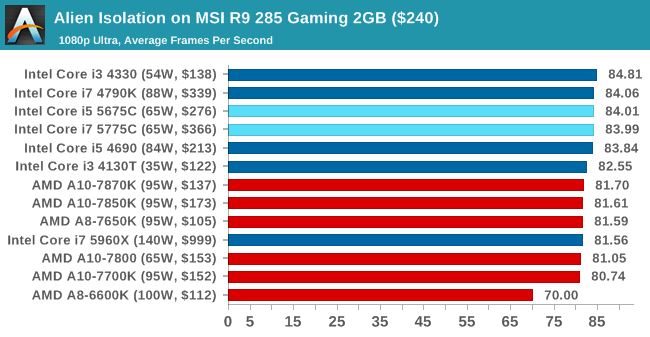
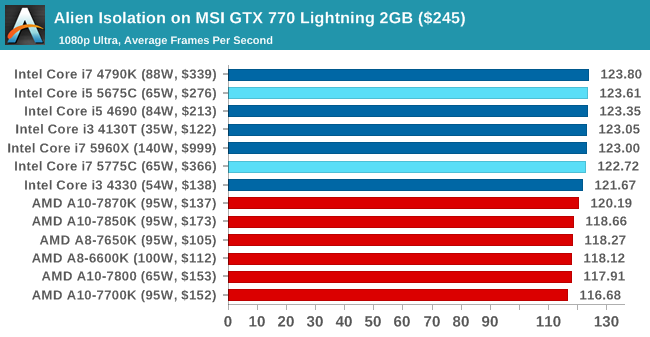
Total War: Attila
The Total War franchise moves on to Attila, another The Creative Assembly development, and is a stand-alone strategy title set in 395AD where the main story line lets the gamer take control of the leader of the Huns in order to conquer parts of the world. Graphically the game can render hundreds/thousands of units on screen at once, all with their individual actions and can put some of the big cards to task.
For low end graphics, we test at 720p with performance settings, recording the average frame rate. With mid and high range graphics, we test at 1080p with the quality setting. In both circumstances, unlimited video memory is enabled and the in-game scripted benchmark is used.
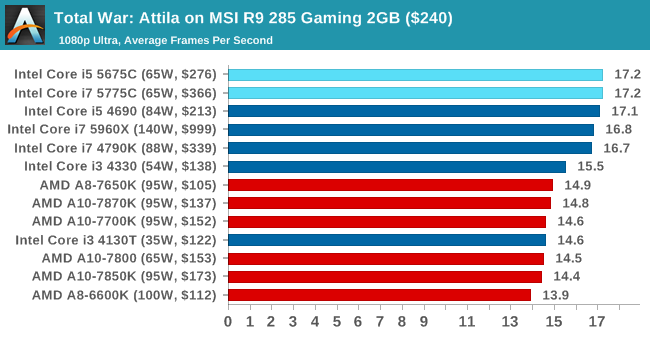
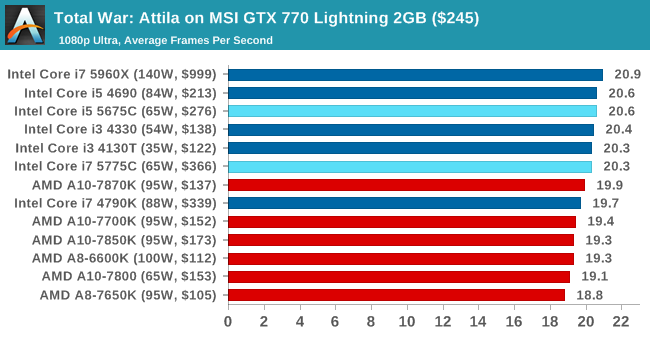
Grand Theft Auto V
The highly anticipated iteration of the Grand Theft Auto franchise finally hit the shelves on April 14th 2015, with both AMD and NVIDIA in tow to help optimize the title. GTA doesn’t provide graphical presets, but opens up the options to users and extends the boundaries by pushing even the hardest systems to the limit using Rockstar’s Advanced Game Engine. Whether the user is flying high in the mountains with long draw distances or dealing with assorted trash in the city, when cranked up to maximum it creates stunning visuals but hard work for both the CPU and the GPU.
For our test we have scripted a version of the in-game benchmark, relying only on the final part which combines a flight scene along with an in-city drive-by followed by a tanker explosion. For low end systems we test at 720p on the lowest settings, whereas mid and high end graphics play at 1080p with very high settings across the board. We record both the average frame rate and the percentage of frames under 60 FPS (16.6ms).
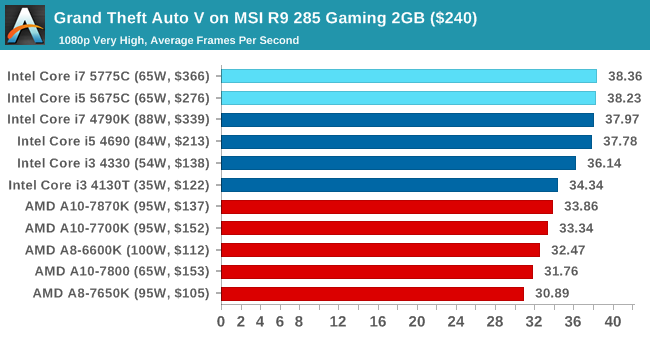
![Grand Theft Auto V on MSI R9 285 Gaming 2GB ($240) [Under 60 FPS]](https://images.anandtech.com/graphs/graph9320/74957.png)
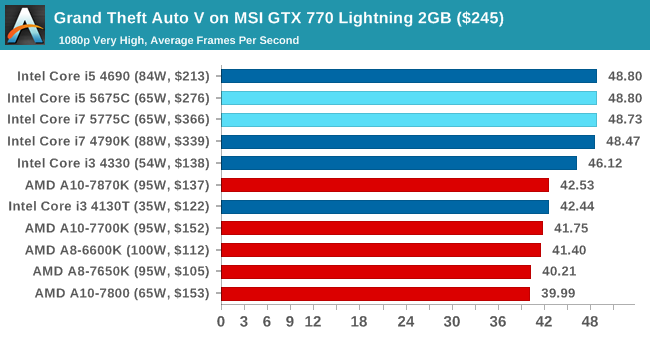
![Grand Theft Auto V on MSI GTX 770 Lightning 2GB ($245) [Under 60 FPS]](https://images.anandtech.com/graphs/graph9320/74967.png)
GRID: Autosport
No graphics tests are complete without some input from Codemasters and the EGO engine, which means for this round of testing we point towards GRID: Autosport, the next iteration in the GRID and racing genre. As with our previous racing testing, each update to the engine aims to add in effects, reflections, detail and realism, with Codemasters making ‘authenticity’ a main focal point for this version.
GRID’s benchmark mode is very flexible, and as a result we created a test race using a shortened version of the Red Bull Ring with twelve cars doing two laps. The car is focus starts last and is quite fast, but usually finishes second or third. For low end graphics we test at 1080p medium settings, whereas mid and high end graphics get the full 1080p maximum. Both the average and minimum frame rates are recorded.

![GRID: Autosport on MSI R9 285 Gaming 2GB ($240) [Minimum FPS]](https://images.anandtech.com/graphs/graph9320/74959.png)
Middle-Earth: Shadows of Mordor
The final title in our testing is another battle of system performance with the open world action-adventure title, Shadows of Mordor. Produced by Monolith using the LithTech Jupiter EX engine and numerous detail add-ons, SoM goes for detail and complexity to a large extent, despite having to be cut down from the original plans. The main story itself was written by the same writer as Red Dead Redemption, and it received Zero Punctuation’s Game of The Year in 2014.
For testing purposes, SoM gives a dynamic screen resolution setting, allowing us to render at high resolutions that are then scaled down to the monitor. As a result, we get several tests using the in-game benchmark. For low end graphics we examine at 720p with low settings, whereas mid and high end graphics get 1080p Ultra. The top graphics test is also redone at 3840x2160, also with Ultra settings, and we also test two cards at 4K where possible.
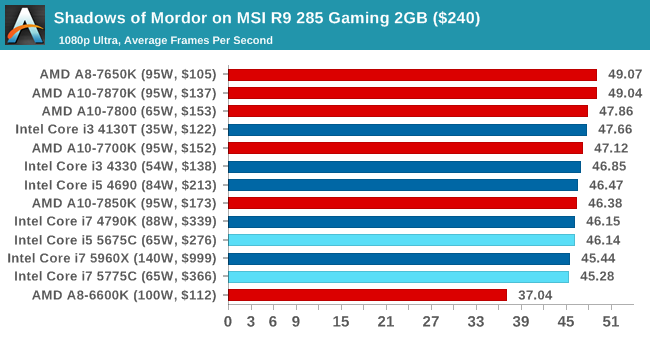
![Shadows of Mordor on MSI R9 285 Gaming 2GB ($240) [Minimum FPS]](https://images.anandtech.com/graphs/graph9320/74961.png)
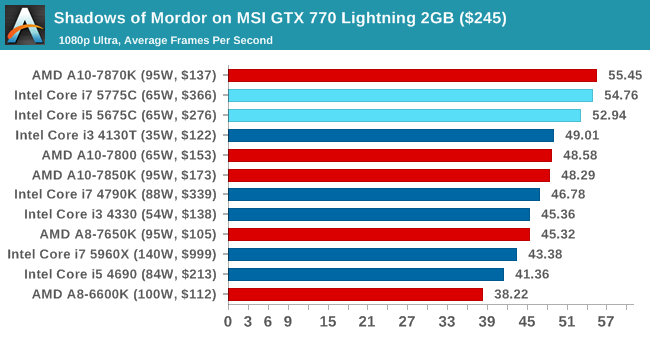
![Shadows of Mordor on MSI GTX 770 Lightning 2GB ($245) [Minimum FPS]](https://images.anandtech.com/graphs/graph9320/74971.png)
Shadows of Mordor at 4K, Single GPU
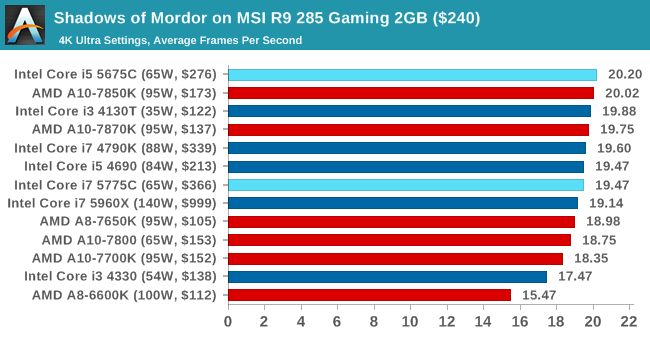
![Shadows of Mordor on MSI R9 285 Gaming 2GB ($240) [Minimum FPS]](https://images.anandtech.com/graphs/graph9320/74963.png)
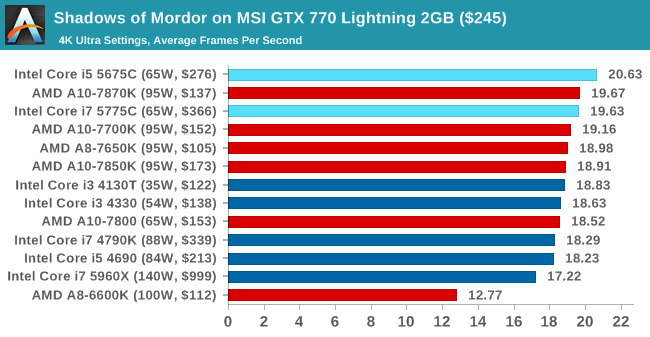
![Shadows of Mordor on MSI GTX 770 Lightning 2GB ($245) [Minimum FPS]](https://images.anandtech.com/graphs/graph9320/74973.png)
Conclusions on Mid-Range Graphics
With the Intel iGPU removed from the picture, what we're seeing here is the combination of Broadwell's architecture improvements, and the Crystal Well eDRAM functioning as an L4 cache for the CPU cores. The biggest benefit here Broadwell-DT was with the R9 285 for GRID on minimum frame rates, showing 75.6 for the 4790K vs 80.06 for the 5775C. Otherwise performance overall is not all that different from what we already see with the best Haswell CPUs, however it's a bit surprising that the Broadwell CPUs don't fall behind, given their rather sizable frequency deficit versus the i7-4790K.















196 Comments
View All Comments
chizow - Tuesday, June 2, 2015 - link
Not really sure how appealing this will be for anyone on LGA1150 for the desktop, given Skylake is just around the corner. Certainly more appealing to heavy duty laptops, maybe NUCs for the better GPU capabilities but the prices are too high compared to low-end CPU + dGPU options (Alienware Alpha at $400-500 comes to mind).CuriousBeing - Tuesday, June 2, 2015 - link
I could never understand why the FX-8350/FX-8370 are never used in these benchmarks....Refuge - Tuesday, June 2, 2015 - link
It is probably because of the new test setup. They haven't re-run everything yet.Not that I consider that a good excuse, I know they are busy though and it is an answer to your question at least if that helps. :P
junky77 - Tuesday, June 2, 2015 - link
Broadwell is not for users who want high integrated GPU performance or something like thatIt's an upgrade root for many with Haswell
alacard - Tuesday, June 2, 2015 - link
Ian, buddy, you really need to step up your game when it comes to analyzing power, temperature, and noise. Seriously, Anandtech used to be a place where you could read a review on a product and have all the information you needed about it and now once i'm done reading an Anandtech review i have to look elsewhere to get the full story.Old Anandtech: Comprehensive and comprehensible.
New Anandtech: Comprehensible only because the reviews have become utterly incomprehensive.
Step it up buddy.
Navvie - Thursday, June 4, 2015 - link
A bit harsh, but agree with the point. I'm now waiting (hoping) that somebody at Ars or TPU gives a more comprehensive review.This Delta power consumption shit has to go as well.
Harry Lloyd - Tuesday, June 2, 2015 - link
So the actual CPU part takes up less than half the die. My forehead cannot take much more of this, there are just to many facepalms these days.And this is what they want us to pay $276 for - a CPU that would take up much less than 100 mm2 and should cost $100.
God, please, let Zen be a good CPU, please. I will pray every day, I want Haswell to be my last Intel CPU for a long time.
I would just like to point out, than an i3 with a 750 Ti will destroy this APU, offering PS4 performance in every single game, for pretty much the same cost.
Namisecond - Wednesday, June 3, 2015 - link
Don't expect Zen to be a some "cheap chip" AMD has stated they're going to focus on performance rather than cost. I'm expecting Zen with HBM to cost as much as comparable Intel offerings.Rather than complaining about the cost of new cutting edge hardware, put your money where your mouth is and get the i3 + 750TI. I have one here and it serves well as a secondary machine (as well as a doorstop). I'd much rather use my 2500K + 960...
shelbystripes - Tuesday, June 2, 2015 - link
I'd really love to see benchmarks of Civilization V on this thing. With such a CPU-intensive game, it'd be interesting to see how much the L4 cache makes an impact, not just with integrated graphics, but also when using dedicated graphics, to see how much the L4 cache helps the raw CPU performance in a game that is so easily CPU-constrained...Peichen - Tuesday, June 2, 2015 - link
I think Civ 5 is still single thread or maybe dual thread and have to process everything in order so each term still take minutes. I have the game at launch and all packs & DLCs and it doesn't stress my overclocked 3770K a bit. No core hits above 40% yet a term still takes forever. The game isn't 64-bit either so there is also that.